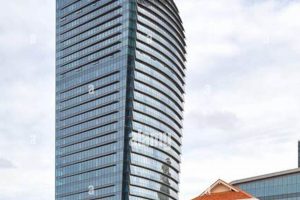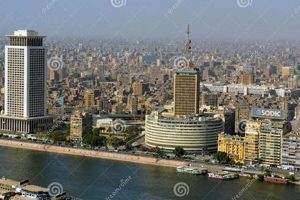Skyscraper height refers to the vertical measurement of a high-rise building, typically exceeding 150 meters or 500 feet. These structures are designed to accommodate a large number of occupants and offer breathtaking views from their elevated vantage points.
The pursuit of skyscraper height has been driven by various factors, including the desire for prestige, improved land utilization in densely populated urban areas, and advancements in architectural engineering. Taller buildings allow for greater floor space and can accommodate more people and businesses within a limited footprint. Historically, the race to construct the world’s tallest skyscraper has been a symbol of economic prosperity and technological prowess.
In addition to their symbolic significance, skyscrapers play a crucial role in modern cities. They provide much-needed office space, residential units, and retail amenities, contributing to the overall economic growth and vitality of urban centers. Moreover, skyscrapers can serve as architectural landmarks, shaping the skyline and identity of a city.
1. Verticality
As a defining characteristic of skyscrapers, verticality is deeply connected to the concept of skyscraper height. The height of a skyscraper is a key factor that sets it apart from other buildings and contributes to its dominance over the surrounding cityscape.
- Height as a Defining Feature
The height of a skyscraper is its most distinctive feature, allowing it to stand out and become a landmark within the urban environment. It is this height that gives skyscrapers their iconic status and makes them instantly recognizable.
- Dominance over the Urban Landscape
Skyscrapers’ height gives them a commanding presence, enabling them to dominate the skyline and shape the overall character of a city. By reaching towards the sky, skyscrapers create a sense of verticality that draws the eye upwards and transforms the urban landscape.
- Maximizing Space and Functionality
Building upwards allows skyscrapers to maximize space utilization in densely populated urban areas. By increasing the height of a building, architects can create more floor space without expanding the footprint, making skyscrapers a practical solution for accommodating large populations.
- Engineering and Architectural Challenges
The pursuit of skyscraper height presents significant engineering and architectural challenges. Constructing buildings that reach hundreds of meters into the sky requires innovative engineering solutions and advanced construction techniques to ensure structural integrity and withstand various environmental forces.
In summary, the verticality of skyscrapers is an integral aspect of their height and contributes to their defining characteristics, urban impact, and architectural significance. Skyscrapers’ height allows them to dominate the skyline, maximize space utilization, and pose unique engineering and architectural challenges, making them iconic landmarks that shape the identity of modern cities.
2. Engineering
The pursuit of skyscraper height poses significant engineering challenges. As buildings reach hundreds of meters into the sky, they are subjected to various environmental forces such as wind, earthquakes, and gravity. To ensure the structural integrity and safety of these immense structures, advanced engineering techniques are employed.
- Structural Systems
Skyscrapers utilize innovative structural systems to withstand the gravitational forces and lateral loads acting upon them. These systems include reinforced concrete cores, steel frames, and diagrid structures, which provide strength, stability, and flexibility to the building.
- Wind Engineering
Skyscrapers are designed to minimize the impact of wind forces. Wind tunnels are used to test building models and assess their aerodynamic performance. Engineers employ various techniques such as setbacks, tapered facades, and tuned mass dampers to mitigate wind-induced vibrations and ensure occupant comfort.
- Seismic Engineering
In earthquake-prone areas, skyscrapers are equipped with sophisticated seismic engineering systems. These systems include base isolation, energy dissipation devices, and viscous dampers, which help to absorb and dissipate seismic energy, reducing the risk of structural damage during earthquakes.
- Fire Safety
Fire safety is a critical concern in high-rise buildings. Skyscrapers are designed with compartmentalization, fire-resistant materials, and advanced sprinkler systems to prevent the spread of fire and ensure the safe evacuation of occupants.
These engineering advancements have enabled the construction of skyscrapers that are not only exceptionally tall but also structurally sound and safe for habitation. The continuous development of innovative engineering techniques pushes the boundaries of skyscraper height and reshapes the skylines of modern cities.
3. Aesthetics
The pursuit of skyscraper height is closely intertwined with the aesthetic considerations that shape their design. As skyscrapers reach new heights, they become prominent landmarks that contribute to the overall visual identity of a city. The architectural styles and influences incorporated into their design play a significant role in defining the character and appeal of urban skylines.
Skyscrapers serve as canvases for architectural expression, reflecting the prevailing design philosophies and cultural influences of their time. Art Deco skyscrapers, for example, are known for their geometric forms, stepped setbacks, and decorative details, while modernist skyscrapers prioritize simplicity, functionality, and the use of glass and steel. The choice of materials, colors, and textures further enhances the aesthetic appeal of skyscrapers, adding depth and visual interest to their facades.
The aesthetic significance of skyscraper height is evident in the way it shapes the urban landscape. Iconic skyscrapers, such as the Empire State Building or the Burj Khalifa, have become instantly recognizable symbols of their respective cities. Their height and distinctive designs create a dramatic visual impact, drawing the eye upwards and contributing to the overall character of the cityscape. By incorporating architectural styles and influences into their design, skyscrapers transcend their function as mere structures and become works of architectural art that enhance the aesthetic appeal and cultural identity of cities.
4. Function
The height of a skyscraper is closely connected to its function and the diverse uses it accommodates. The verticality of skyscrapers allows for a more efficient use of land, making them suitable for accommodating a variety of functions within a single structure. This multifunctional aspect is a key component of skyscraper height and contributes to its significance in modern urban environments.
Skyscrapers provide substantial office space, catering to the needs of businesses and organizations. The height of the building allows for a large number of floors, which can be tailored to specific office requirements. This vertical stacking of office space enables businesses to consolidate their operations within a single location, fostering collaboration and efficiency.
In addition to office space, skyscrapers often incorporate residential units, offering a unique blend of urban living and convenience. The height of the building allows for a greater number of residential units, providing housing options for a diverse population within the heart of the city. These residential units may range from luxury apartments to affordable housing, catering to different socioeconomic groups.
Skyscrapers also serve as hubs for retail and commercial activities. The lower floors of skyscrapers often house retail stores, restaurants, and other amenities, creating a vibrant and dynamic environment at the base of the building. This integration of retail space enhances the overall functionality of the skyscraper and makes it a convenient destination for residents, workers, and visitors alike.
Understanding the connection between skyscraper height and function is crucial for architects, urban planners, and real estate developers. By considering the diverse functions that a skyscraper can accommodate, they can design and construct buildings that meet the evolving needs of modern cities. This understanding also informs policy decisions related to zoning and land use, ensuring that skyscrapers contribute positively to the urban fabric and enhance the quality of life for city dwellers.
5. Density
The connection between “Density: By building upwards, skyscrapers allow for efficient land use in densely populated urban areas.” and “skyscraper height” is significant and multifaceted. Skyscrapers, by virtue of their height, offer a practical solution to accommodate a large number of people and functions within a limited footprint. This efficient use of land is particularly crucial in densely populated urban areas where land is scarce and expensive.
Skyscrapers maximize vertical space, allowing for more floor area and usable space without expanding the building’s footprint. This vertical stacking of space enables the creation of high-density developments that can accommodate a substantial population within a relatively small geographical area. By building upwards, skyscrapers reduce urban sprawl and preserve valuable land for other purposes, such as parks, green spaces, and infrastructure.
The practical significance of understanding this connection is evident in the design and planning of modern cities. Urban planners and architects leverage the height of skyscrapers to create compact and efficient urban environments. This approach promotes sustainable development, reduces traffic congestion, and fosters walkability. Moreover, high-density developments around skyscrapers create vibrant and diverse neighborhoods where residents have access to a wide range of amenities and services within close proximity.
In conclusion, the connection between skyscraper height and density is a critical factor in addressing the challenges of urbanization and land scarcity in modern cities. By building upwards, skyscrapers allow for efficient land use, maximizing space utilization, and promoting sustainable urban development.
6. Sustainability
The pursuit of skyscraper height goes hand in hand with the growing emphasis on sustainability in modern architecture. As buildings reach unprecedented heights, their environmental impact becomes increasingly significant, making sustainable design an imperative.
- Energy Efficiency
Skyscrapers are incorporating advanced energy-efficient technologies to reduce their carbon footprint. These include high-performance glazing, efficient lighting systems, and smart building management systems that optimize energy consumption. By reducing energy usage, skyscrapers can minimize their environmental impact and lower operating costs.
- Sustainable Materials
The construction of skyscrapers involves the use of massive amounts of materials. Sustainable skyscrapers prioritize environmentally friendly materials, such as recycled steel, low-VOC paints, and sustainably sourced wood. These materials reduce the building’s carbon footprint and contribute to a healthier indoor environment.
- Water Conservation
Skyscrapers can be water-intensive structures. Sustainable design incorporates water-saving fixtures, rainwater harvesting systems, and efficient irrigation techniques. By reducing water consumption, skyscrapers can minimize their environmental impact and contribute to water conservation efforts.
- Indoor Environmental Quality
Tall buildings can create unique challenges for indoor air quality. Sustainable skyscrapers prioritize healthy indoor environments by incorporating natural ventilation, air filtration systems, and green spaces. These measures improve occupant well-being, productivity, and overall quality of life.
By embracing sustainable design principles, modern skyscrapers are not only reaching for the sky but also striving to minimize their environmental impact. The pursuit of skyscraper height and sustainability are interconnected, driving innovation and shaping the future of high-rise architecture.
7. Cultural Impact
Skyscrapers, with their towering heights and distinctive designs, have transcended their function as mere buildings to become cultural icons that shape the identity of cities. This cultural impact is deeply intertwined with the height of these structures, making it an integral aspect of understanding their significance.
- Vertical Dominance and Urban Identity
Skyscrapers’ height allows them to dominate the skyline, becoming instantly recognizable symbols of cities. The Empire State Building is synonymous with New York City, while the Petronas Towers define the cityscape of Kuala Lumpur. This vertical dominance contributes to the unique identity and character of cities, making skyscrapers powerful cultural landmarks.
- Architectural Expression and Cultural Values
The design of skyscrapers often reflects the cultural values and aspirations of the time and place in which they are built. Art Deco skyscrapers, with their sleek lines and geometric forms, embody the optimism and modernity of the early 20th century. The Burj Khalifa, with its soaring hei
ght and intricate facade, reflects Dubai’s ambition and global aspirations. - Tourism and Cultural Significance
Skyscrapers have become major tourist attractions, drawing visitors from around the world. Observation decks, such as the Top of the Rock in New York City and the Tokyo Skytree, offer breathtaking views and a unique perspective on the city below. These attractions contribute to the cultural significance of skyscrapers and enhance the tourism industry.
- Cultural Identity and Sense of Place
Skyscrapers can shape the cultural identity of a city’s residents. They create a sense of place and belonging, fostering a connection between people and their urban environment. The Willis Tower in Chicago, for example, is a beloved landmark that evokes a sense of civic pride and community.
In conclusion, the cultural impact of skyscrapers is inextricably linked to their height. Skyscrapers’ vertical dominance, architectural expression, tourism appeal, and ability to shape cultural identity all stem from their towering stature. These cultural landmarks not only define the skylines of cities but also contribute to their unique character and sense of place.
Skyscraper Height FAQs
This section addresses frequently asked questions (FAQs) related to skyscraper height, providing informative answers to common concerns and misconceptions.
Question 1: What are the main factors driving the pursuit of skyscraper height?
The pursuit of skyscraper height is influenced by several key factors, including economic prosperity, technological advancements, architectural innovation, and the desire for prestige. Taller buildings can accommodate more occupants and businesses, making efficient use of valuable land in urban areas. Technological progress has enabled the development of innovative structural systems and construction techniques that allow for greater heights. Architectural ambition and the pursuit of iconic landmarks further contribute to the race to build taller skyscrapers.
Question 2: How do skyscrapers ensure structural stability and safety at extreme heights?
Skyscrapers employ advanced engineering techniques to ensure structural stability and safety. These techniques include the use of reinforced concrete cores, steel frames, and diagrid structures, which provide strength and flexibility to withstand gravitational forces and lateral loads. Wind engineering and seismic engineering play crucial roles in mitigating the impact of wind forces and earthquakes. Fire safety measures, such as compartmentalization and sprinkler systems, are also essential to protect occupants in the event of a fire.
Question 3: What are the key considerations for sustainable design in skyscrapers?
Sustainable design is a critical aspect of modern skyscrapers. Architects and engineers prioritize energy efficiency by incorporating high-performance glazing, efficient lighting systems, and smart building management systems. Sustainable materials, such as recycled steel and low-VOC paints, reduce the environmental impact of construction. Water conservation measures, including rainwater harvesting systems and efficient irrigation techniques, are also employed. Additionally, skyscrapers strive to maintain healthy indoor environmental quality through natural ventilation, air filtration systems, and the incorporation of green spaces.
Question 4: How do skyscrapers impact the urban environment and surrounding communities?
Skyscrapers have a significant impact on the urban environment and surrounding communities. They can contribute to increased population density, creating vibrant and diverse neighborhoods. However, careful planning is necessary to mitigate potential negative impacts, such as traffic congestion and overshadowing. Mixed-use developments that incorporate residential, commercial, and public spaces can enhance the livability and sustainability of skyscraper-dominated areas.
Question 5: What are the future trends and innovations in skyscraper height?
The future of skyscraper height is shaped by ongoing advancements in materials science, structural engineering, and sustainable design. New materials, such as carbon fiber and ultra-high-strength concrete, are enabling the construction of even taller and more slender structures. Innovative structural systems, inspired by nature and biology, are being explored to achieve greater heights and resilience. Sustainability will remain a key focus, with skyscrapers incorporating renewable energy sources, advanced energy management systems, and biophilic design elements that enhance occupant well-being.
Question 6: How do skyscrapers contribute to the cultural identity and global recognition of cities?
Skyscrapers have become iconic landmarks that shape the cultural identity and global recognition of cities. Their distinctive designs and towering heights make them instantly recognizable symbols, often associated with economic power, technological prowess, and architectural ambition. Skyscrapers serve as tourist attractions, drawing visitors from around the world to experience their grandeur and panoramic views. They also foster a sense of pride and belonging among city residents, creating a unique and memorable skyline that contributes to the city’s overall identity and brand.
In summary, skyscraper height is a complex and multifaceted concept that encompasses various dimensions, including engineering challenges, architectural innovation, urban impact, and cultural significance. Understanding the key considerations and advancements related to skyscraper height is essential for appreciating the role these towering structures play in shaping modern cities and skylines.
Transition to the next article section: This concludes our comprehensive exploration of skyscraper height. To delve deeper into specific aspects of skyscraper design, construction, or impact, please refer to the following sections.
Skyscraper Height Tips
Understanding the various dimensions of skyscraper height can provide valuable insights for architects, engineers, urban planners, and anyone interested in the design and impact of these towering structures.
Tip 1: Prioritize Structural Integrity
Ensure the structural stability of skyscrapers by employing robust engineering techniques, such as reinforced concrete cores, steel frames, and wind-resistant designs, to withstand gravitational forces, lateral loads, and environmental factors.
Tip 2: Embrace Energy Efficiency
Incorporate sustainable design principles to reduce energy consumption and environmental impact. Implement energy-efficient lighting systems, high-performance glazing, and smart building management systems that optimize energy usage.
Tip 3: Maximize Space Utilization
Utilize the verticality of skyscrapers to accommodate a large number of occupants and functions. Design mixed-use developments that provide office space, residential units, retail amenities, and public spaces, fostering vibrant and diverse urban environments.
Tip 4: Consider Cultural Context
Incorporate architectural styles and influences that reflect the cultural identity and aspirations of the city. Design skyscrapers that contribute to the overall aesthetic appeal and visual harmony of the urban landscape.
Tip 5: Enhance Indoor Environmental Quality
Prioritize occupant well-being by incorporating natural ventilation, air filtration systems, and green spaces. Create healthy and comfortable indoor environments that promote productivity and overall quality of life.
Tip 6: Foster Community Connections
Design skyscrapers that encourage community engagement and interaction. C
reate public spaces, green areas, and mixed-use developments that foster a sense of place and belonging among residents and visitors alike.
Tip 7: Stay Informed about Innovations
Keep abreast of advancements in materials science, structural engineering, and sustainable design. Explore innovative construction techniques and materials that enable the construction of taller, more efficient, and sustainable skyscrapers.
Tip 8: Seek Collaboration and Expertise
Foster collaboration among architects, engineers, urban planners, and other stakeholders. Leverage the collective knowledge and expertise to create skyscrapers that meet the evolving needs of modern cities and contribute positively to the urban fabric.
By incorporating these tips into the design and construction of skyscrapers, we can create structures that not only reach for the sky but also enhance the quality of life for occupants, contribute to the urban environment, and embody the cultural aspirations of our time.
Skyscraper Height
Our exploration of skyscraper height has illuminated the multifaceted nature of these towering structures, encompassing engineering prowess, architectural innovation, urban impact, and cultural significance. Skyscrapers have reshaped skylines, redefined urban density, and become iconic landmarks that embody the aspirations of modern cities.
As we continue to push the boundaries of skyscraper height, it is imperative to prioritize structural integrity, embrace sustainable design, and maximize space utilization. By incorporating these principles into the design and construction of skyscrapers, we can create structures that not only reach for the sky but also contribute positively to the urban environment and enhance the quality of life for occupants.
The pursuit of skyscraper height is a testament to human ingenuity and ambition. These towering giants will continue to shape the future of urban landscapes, serving as symbols of progress, innovation, and the ever-evolving relationship between humanity and the sky.







